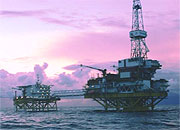“I believe this will open the way for many joint projects, especially in the area of energy,” President Dmitri A. Medvedev of Russia said at a news conference. The agreement is subject to ratification by by the legislature of each country.
The Norwegian prime minister, Jens Stoltenberg, said it showed good will in the face of rising international anxiety over who controls the Arctic seabed, which by some estimates contains a quarter of the world’s undiscovered fossil fuels.
“This is a confirmation that Norway and Russia, two large polar nations, do not have a policy about racing, but a policy about cooperation,” he said.
When Russian scientists planted a flag on the seabed at the North Pole in 2007, it seemed that a “race to the Arctic” was on, with northern nations aggressively jostling for the right to exploit resources that were previously out of reach.
The chairman of Norway’s Ocean Futures research institute, Willy Ostreng, said the agreement’s foundation in international law and bilateral negotiation bodes well for resolving future conflicts between other countries in the far north, where interest in shipping and offshore petroleum production may intensify if the polar ice cap continues to recede in response to warming temperatures.
“It’s a model case for what may happen in the future in the Arctic,” Mr. Ostreng said.
The Norwegian and Russian frontiers cap Europe’s northernmost bulge. The new delimitation extends the two countries’ 122-mile land border northward beyond all the islands of the Barents Sea and into the Arctic Ocean, although the two leaders did not provide an exact northward distance.
Conventional practice elsewhere in the world has been to position maritime boundaries at the midpoint between opposing land masses, and for 40 years that has been Norway’s goal with respect to its Svalbard archipelago to the west and the Russian island groups of Novaya Zemlya and Franz Josef Land to the east.
Russia argued instead for a “meridian line” boundary running more or less straight north from the mainland, which would have provided it with an additional 67,000 square miles of economic territory — about equal to the entire Norwegian sector of the North Sea, whose oil resources have made Norway a rich country.
Mr. Stoltenberg said the line approved on Tuesday splits that disputed area nearly in half, which means the line will still run considerably closer to the Norwegian islands than the Russian ones. A number of oil or gas fields identified by Russian seismic surveys in the 1980s are thought to straddle the line.
“Both parties believe the disputed area contains rich deposits of mineral resources, in particular oil and gas,” said Mr. Ostreng. “But they don’t know for sure. And when you don’t know for sure, you act as if the area is extremely rich. It is not easy to give up strategic resources.”
A spokesman for Greenpeace, the international environmental organization, said he was startled by how the two leaders talked about oil and gas exploration immediately after announcing the new boundary.
“It just shows the greediness of Russia and Norway that the first thing they talked about is not global warming, which is what’s making this area suddenly accessible, but resource extraction,” said Truls Gulowsen, head of the group’s Norway branch. “This part of the planet is extremely sensitive. It is often covered with ice and there is no technology to clean spilled oil and chemicals out of ice.”
Geologists say the eastern Barents, under Russian economic stewardship, probably contains far more oil and gas than the Norwegian sector, though the Norwegians have beaten their neighbors to the punch by starting production in a western Barents field called Snow White. Based on expertise gained there, a Norwegian company, Statoil, has signed up to help Russia’s state gas giant, Gazprom, develop a large offshore field called Shtokman far out at sea on the Russian side of the Barents. That technologically demanding project has been delayed, however, by low gas prices.
At a meeting in Canada of the Arctic nations last month, Foreign Minister Jonas Gahr Store of Norway seemed to express frustration over Russia’s longstanding opposition to placing the maritime boundary at an equal distance between islands of the two nations. He was widely quoted as saying Russia was “not yet a stable, predictable state.”
The two states have clashed in the past over fishing rights and practices in the Barents Sea, which contains vast stocks of cod. But in recent years Russia and Norway have worked closely on a shared fisheries management system. So while the new dividing line will add clarity it will not alter fishing practices on a large scale, Mr. Ostreng said.
The area in question qualifies as the high seas, he said, so no matter where the line was drawn it would not affect passage by naval vessels or commercial ships.
"The New York Times"
03 Января 2026 | суббота | 09:04


